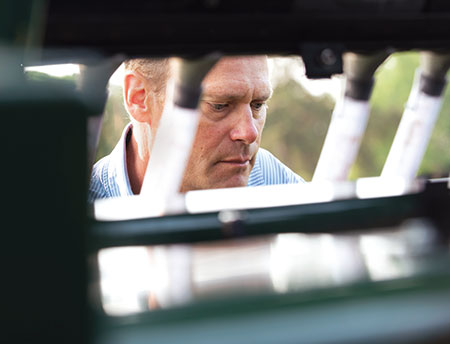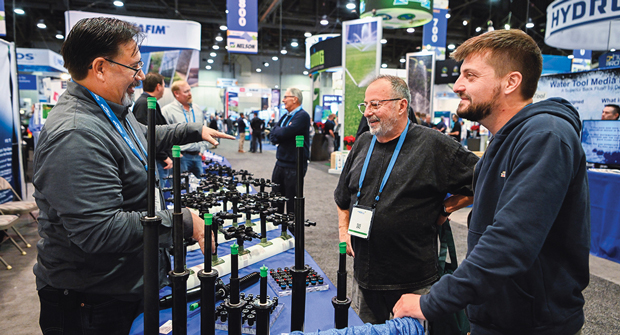Minnesota superintendents share lessons learned in regrassing projects

Jeff Johnson, superintendent of Minneapolis, Minn.’s The Minikahda Club, chose to regrass his course to reduce disease pressure. (Photo: Jamey Guy Photography)
For Jeff Johnson, superintendent of The Minikahda Club in Minneapolis, Minn., and Jared Keller, superintendent of the Minneapolis Golf Club in St. Louis Park, Minn., the grass truly is greener on the other side of their regrassing projects.
Johnson’s decision to regrass was simple: eliminate turf susceptible to dollar spot, snow mold and brown patch and keep his course competitive with surrounding golf courses.
Mother Nature tipped Keller’s hand as Minneapolis GC suffered several years of winter injury on its Poa annua greens. In 2019, Keller had to deal with ice encasement on top of more winter injury. That was the moment when he decided it was time to find another option. Plus, he saw Johnson’s successes the year before, just 5 miles away at Minikahda.
“Two out of three years we got hit pretty hard, and the members decided we just couldn’t operate that way,” he says. “(Members) voted through the regrass conversion, and that July, we shut down.”

Both Johnson and Keller used Turfco’s TriWave 60 tractor-mounted overseeders to regrass their courses’ fairways. (Photo: Turfco)
Planning process
Johnson says the regrassing project for his course started about three years before the first burn-down herbicide to eliminate his mix of bentgrass and Poa annua. He talked to other superintendents who regrassed to get a better handle on what to expect.
A vital part of the project, Johnson says, was communicating to Minikahda Club members about the scope of the project. He held a town hall to answer any of the members’ questions.
“They needed to be informed on what was going to happen, the process, the timing and how long the course was going to be closed,” he says.
Keller says while there was talk of starting the regrassing project in the spring of 2019, he decided it was better to aim for mid-August to get a successful bentgrass take and avoid competition from Poa annua. From the time his members decided to move forward with regrassing, he had about three months to prepare. Lucky for Keller, Johnson had done his homework for his project, and Keller says his membership was familiar with the work at Minikahda.
“Between reviewing the NTEP data to see what performed best and with our members’ knowledge of what they had done over at Minikahda, it was a pretty easy decision for us,” Keller says.

A successful grow in comes down to a healthy dose of preparation, ensuring the necessary supplies are on hand and, of course, Mother Nature. (Photos: Turfco)
Keller and his team performed an irrigation audit before regrassing. Team members took a look at all the irrigation heads to make sure everything was in top shape and turning as they should be.
“Even with that additional effort, we still ran into some heads that weren’t functioning,” he says. “Those issues quickly popped up once we put the seed in the ground. It doesn’t get water, and you start to see (irrigation issues) in the first couple of weeks.”
Johnson says a successful regrassing project comes down to anticipating and preparing for any issues that might arise such as inclement weather. He says it was also critical to involve and inform his staff throughout the whole project.
“They helped a lot with the planning and the preparation, so they were highly involved with the project from the get-go,” he says.
Burn it down, grow it up

Johnson said it was nice to have Turfco nearby to lean on for advice on details such as proper application depth. (Photo: Jamey Guy Photography)
Though it might seem simple on paper, Johnson says the idea of essentially killing all the existing 31 acres of fairways and replanting it was a daunting task.
“I grew up in agriculture, and my dad has planted a crop every year, and every year, it comes up,” he says. “Planting seeds is really no different than planting a crop. Water and fertilize it, and it’s going to grow. Then, you need to start managing it culturally to get it to where you want it to be.”
Johnson closed his course on July 23, 2018, and opened 11 months later on June 25, 2019. Keller closed his course on July 8, 2019, and reopened on July 1, 2020. Once open, Johnson took a conservative approach with the turf and did not allow golf carts the first month.
Keller and Johnson selected 007 creeping bentgrass greens and tees and used Dominant X-Treme creeping bentgrass for the courses’ fairways. Johnson says the varieties are resistant to dollar spot, snow mold and brown spot. Keller says he made sure to order fertilizers ahead of time to help the seed get off to the right start.

Both Keller and Johnson selected Dominant X-Treme creeping bentgrass for the fairways of Minikahda Club (photographed) and Minneapolis GC. (Photo: Turfco)
“Aside from just securing the necessary supplies you need, 2,500 pounds of bentgrass seed is not always readily available,” Keller says. “We secured that a few months in advance. We got all of our fertilizers on hand.”
Keller and his crew looked at eliminating shady areas on the course and 36 acres of fairways to prevent Poa encroachment.
“We had to address the growing environment first, and we had about 15 trees that had to be cut down to resolve some shade issues,” he says.
Johnson says it also helped to have the assistance of Turfco Manufacturing — headquartered nearby — and three of the company’s TriWave 60 tractor-mounted overseeders to execute the project on Minikahda Club’s fairways.
“It was a comforting knowing that support was right there for us,” he says.
Turfco worked with the team to fine-tune the seed depth of the TriWave 60s at Minikahda Club and the Minneapolis Golf Club. Scott Kinkead, executive vice president of Turfco, says this is an important step to ensure consistent application and a more consistent seed take. Kinkead says the TriWave’s floating heads and WaveBlades ensure good seed-to-soil contact and follow the courses’ contours for consistent application depth.

Floating heads on the TriWave are suited for courses with undulations, says Scott Kinkead, executive vice president of Turfco. (Photo: Jamey Guy Photography)
“When you have an older golf course, where you have a lot of undulations, it’s pretty critical to be able to make sure you get a good take and you’re not having to go in so many different directions,” Kinkead says.
One thing both Johnson and Keller say was difficult to plan for was Mother Nature. Keller said his first seed application hit in mid-August, and the last application went down two weeks later.
“We had a dream of mid-August, but we had over a foot of rain the three weeks following,” Keller says. “When you’re seeding in bare soil, that amount of rain, and as quick as it came, it wreaked havoc on the project. We did what we could to cover greens to prevent any damage, but we ended up reseeding and refloating, regrading our greens three different times because of what Mother Nature had to offer.”
He says it was frustrating having areas with thick bentgrass and other areas that were bare.
“We were really happy with the results and the way the equipment performed,” he says, aside from how Mother Nature complicated the project. “Getting it to fill in uniformly was frustrating, but we got there eventually.”
Words of advice

Both Keller and Johnson say communicating with members throughout the regrassing project is a critical step. (Photo: Jamey Guy Photography)
Keller says it’s important to focus on the positive when going through such a big overhaul. There will be spots that don’t grow in perfectly at first.
“Focus on the 90 percent positive, and don’t dwell on the 10 percent of the golf course that may not be filling in the way that you expected it to,” he says. “When you’re doing a project of this caliber, you’re always going to have certain greens or certain areas that don’t fill in the way the rest of the golf course does. I was guilty myself of every morning running out to that spot that might be troublesome, and that can take an emotional toll.”
Kinkead says aside from having enough supplies to execute the project and having contingency plans for Mother Nature, communication with members is a big key.
“Having those meetings and making sure that people are for it, that’s the first and most challenging step,” he says. “A pretty important part is what people you can bring in to be able to explain to the membership the value and the importance of (the project) and how it’s going to go.”
Still, some members are going to oppose the project no matter what.
“If you change the towels in the locker room, you’re going to have members upset,” he says.










